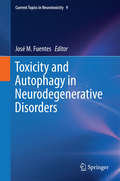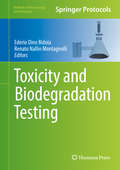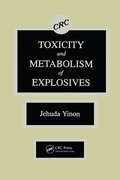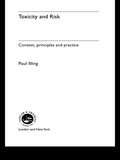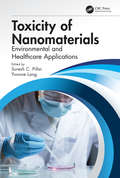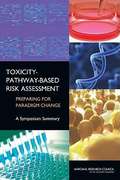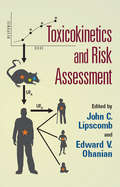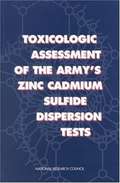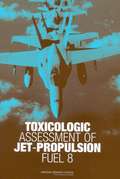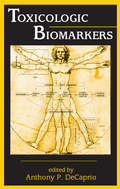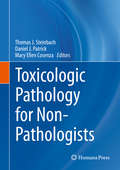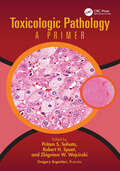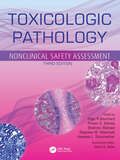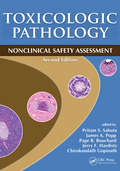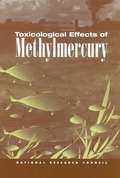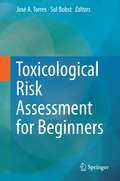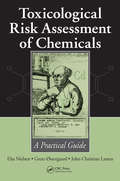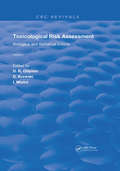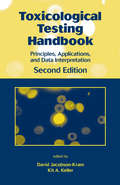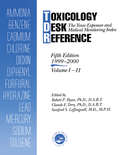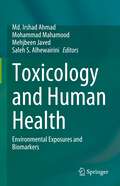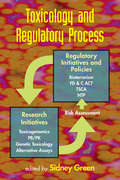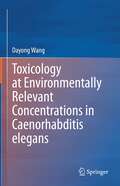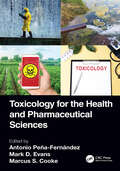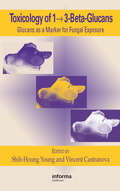- Table View
- List View
Toxicity and Autophagy in Neurodegenerative Disorders
by José M. FuentesComprehensive overview of different aspects of autophagy as it relates to neurodegenerative diseases. The pathogenesis of the main neurodegenerative disorders includes either the accumulation of altered or misfolded proteins or exposure to several toxics. Autophagy constitute one of the two principal cellular pathways implicate in the clearance of these material and can serve as a neuroprotective mechanism. Topics include: the role of autophagy in the brain, the role of autophagy in the principal neurodegenerative disorders, and the mechanism by which different molecules cause neurotoxicity and the role autophagy plays.
Toxicity and Biodegradation Testing
by Ederio Dino Bidoia Renato Nallin MontagnolliThis volume presents a broad compendium of techniques used in biodegradation and toxicological research. Through both legacy and up-to-date approaches to practical methodologies with proven results, the book examines the role and applications of analytical biodegradation quantification as it applies to the environmental sciences, particularly in the range of byproducts that are usually linked to toxicology, and the test organisms most often used in toxicity testing. Topics include scientific and technical feasibility studies, contaminant impacts evaluation, study design and analytical techniques, key methodologies required to prepare the biodegradation and toxicology protocols, as well as the handling of microbial communities related to such processes. Written for the Methods in Pharmacology and Toxicology series, chapters deal with a critical discussion of laboratory scale experiments, as well as full scale in situ and ex situ apparatus, with each chapter containing both a discursive section along with a detailed methods section. Detailed and authoritative, Toxicity and Biodegradation Testing is primarily focused toward the environmental sciences researcher, while the range of techniques also provides an introduction to biodegradation and toxicology methods for researchers outside of the field.
Toxicity and Metabolism of Explosives
by Jehuda YinonThe purpose of this important monograph is to provide the reader with a better understanding of the toxicity, channels of absorption, and metabolism of explosives by the body. This one-of-a-kind work also incorporates the symptoms and clinical manifestations of poisoning by these compounds. It discusses how the disposal of explosives and their degr
Toxicity and Risk: Context, Principles and Practice
by H Paul IllingThis book aims to set out the political, social, legal and scientific underpinning of risk assessment and risk management for toxic substances. It describes the principles and processes the practitioners undertake when looking at the regulatory risk implications of their work.
Toxicity of Nanomaterials: Environmental and Healthcare Applications
by Suresh C. Pillai Yvonne LangThis comprehensive book, edited by two leading experts in nanotechnology and bioengineering with contributions from a global team of specialists, provides a detailed overview of the environmental and health impacts associated with the toxicology of nanomaterials. Special attention is given to nanomaterial toxicity during synthesis, production and application, and chapters throughout are focused on key areas that are important for future research and development of nanomaterials. This book will be of interest to advanced students studying biomedical engineering and materials science, PhD researchers, post-docs and academics working in the area of nanotechnology, medicine, manufacturing and regulatory bodies. Features: Collates and critically evaluates various aspects of the toxicology of nanomaterials in one comprehensive text Discusses the various effects of nanocrystals including the morphologies on cytotoxicity, in addition to the environmental and cytotoxicity risks of graphene and 2D nanomaterials Explores practical methods of detection and quantification, with applications in the environmental and healthcare fields
Toxicity-Pathway-Based Risk Assessment: Preparing for Paradigm Change - A Symposium Summary
by National Research Council of the National AcademiesIn 2007, the National Research Council envisioned a new paradigm in which biologically important perturbations in key toxicity pathways would be evaluated with new methods in molecular biology, bioinformatics, computational toxicology, and a comprehensive array of in vitro tests based primarily on human biology. Although some considered the vision too optimistic with respect to the promise of the new science, no one can deny that a revolution in toxicity testing is under way. New approaches are being developed, and data are being generated. As a result, the U.S. Environmental Protection Agency (EPA) expects a large influx of data that will need to be evaluated. EPA also is faced with tens of thousands of chemicals on which toxicity information is incomplete and emerging chemicals and substances that will need risk assessment and possible regulation. Therefore, the agency asked the National Research Council to convene a symposium to stimulate discussion on the application of the new approaches and data in risk assessment. The symposium was held on May 11-13, 2009, in Washington, DC, and included presentations and discussion sessions on pathway-based approaches for hazard identification, applications of new approaches to mode-of-action analyses, the challenges to and opportunities for risk assessment in the changing paradigm, and future directions.
Toxicokinetics and Risk Assessment
by John C. Lipscomb Edward V. OhanianToxicokinetics in Risk Assessment discusses the noncancer risk assessment process and its reliance on uncertainty factors in order to facilitate the continued study and refinement of the scientific basis for health risk assessment. This text clearly demonstrates the application of physiologically-based pharmacokinetic (PBPK) modeling in human healt
Toxicologic Assessment Of The Army's Zinc Cadmium Sulfide Dispersion Tests
by Subcommittee On Zinc Cadmium SulfideDuring the 1950s and 1960s, the U.S. Army conducted atmospheric dispersion tests in many American cities using fluorescent particles of zinc cadmium sulfide (ZnCdS) to develop and verify meteorological models to estimate the dispersal of aerosols. Upon learning of the tests, many citizens and some public health officials in the affected cities raised concerns about the health consequences of the tests. This book assesses the public health effects of the Army's tests, including the toxicity of ZnCdS, the toxicity of surrogate cadmium compounds, the environmental fate of ZnCdS, the extent of public exposures from the dispersion tests, and the risks of such exposures.
Toxicologic Assessment of Jet-Propulsion Fuel 8
by Subcommittee on Jet-Propulsion Fuel 8This report provides a critical review of toxicologic, epidemiologic, and other relevant data on jet-propulsion fuel 8, a type of fuel in wide use by the U. S. Department of Defense (DOD), and an evaluation of the scientific basis of DOD’s interim permissible exposure level of 350 mg/m3
Toxicologic Biomarkers
by Anthony P. DeCaprioResponding to the explosion of advances in the use of biomarkers to efficiently, rapidly, and economically evaluate the health effects of chemical entities, this authoritative reference provides a detailed overview of the theory, development, and practical application of biomarkers in the toxicological, environmental, forensic, and pharmaceutical s
Toxicologic Pathology for Non-Pathologists (Springer Protocols Handbooks Ser.)
by Thomas J. Steinbach Daniel J. Patrick Mary Ellen CosenzaThis extensive volume began as a short course primarily geared toward toxicologists who want to expand their understanding of toxicologic pathology in order to be better study directors while also proving to be of great interest to other drug development scientists and regulatory reviewers. The overall goal is to help non-pathologists understand, contextualize, and communicate the pathology data and interpretations from the study pathologist in a practical and usable format. Within the book, readers will find an overview of general pathology concepts that include fundamental vocabulary and the basics of pathophysiological processes, along with numerous chapters devoted to pathology in specific organ systems as well as topics such as biomarkers, correlation of clinical pathology endpoints (chemistry and hematology) with microscopic changes, and well-known pathology findings for classes of toxic substances. Authoritative, practical, and comprehensive, Toxicologic Pathology for Non-Pathologists aims to help non-pathologists understand, converse in, and apply a basic understanding of pathology in their day-to-day careers.
Toxicologic Pathology: A Primer
by Gregory ArgentieriThere has been an enormous growth of interest in the field of toxicologic pathology and particularly on its impact on nonclinical safety assessment in global drug development and in the environment. Toxicologic pathologists play an important role in detecting test article-related adverse effects by characterizing morphologic changes in animal tissues and/or body fluids under prescribed study conditions or less clearly defined conditions in the environment and in the interpretation of these findings relative to human risk. In fact, pathology evaluation is often the single most important decision-making factor in nonclinical safety assessments as 80% of drug candidate attrition has been attributed to pathology findings in toxicity studies. There are currently no primers or basic overviews covering the field of toxicologic pathology, whereas there are at least several basic books that cover the sister field of toxicology.Toxicologic Pathology: A Primer is a practical, easy-to-use reference designed to contain core information provided by board-certified veterinary pathologists, all experts in the field. The Primer contains the basic, underlying principles of toxicologic pathology at the introductory level; thus it will be valuable to the veterinary pathology student who may be considering a career in the field as well as a companion to the seasoned toxicologic pathologist who wants a succinct refresher. The Primer is arranged as chapters presenting each major organ system preceded by an overview chapter covering the field of toxicologic pathology followed by a “concept” chapter describing the role of toxicologic pathology in drug development. Photomicrographs and illustrations provide visual context.The organ system chapters provide histopathologic descriptions of lesions observed in toxicity studies of test articles in drug development and testing of chemicals that may negatively impact the environment. Each organ system chapter provides additional information related to a particular lesion to aid the reader in better understanding its toxicologic significance relative to human risk.Each organ system chapter contains: A brief introduction A succinct description of the anatomy and physiology of the system Descriptions of the most important pathological lesions Differential diagnoses Biological consequences, pathogenesis, and/or mechanism of lesion formation Associated clinical pathology correlates Nonclinical safety scientists such as study directors, non-pathology-oriented contributing scientists such as senior toxicology report reviewers, scientific management of Contract Research Organizations (CROs), and students should find the Primer useful in helping them understand the fundamentals of toxicologic pathology.
Toxicologic Pathology: Nonclinical Safety Assessment
by Pritam S. Sahota Zbigniew W. Wojcinski Page R. Bouchard Shannon Wallace Vanessa L. Schumacher David. A. SabioThe new edition provides practical and timely information for toxicologic pathologists working in drug discovery and development. The introductory concept chapters are consolidated into two more concise and better-organized introductory chapters. The two concept chapters introduce the reader to pharmaceutical R&D, the role of the pathologist in the process, and critical partner scientific disciplines with whom the pathologist will collaborate. In this revision, the organ system chapters incorporate more consistent commentary and guidance on the molecular mechanism of action, human translational relevance, and regulatory impact of pathological findings as they are described in these chapters.Key Features: Aids scientists in understanding spontaneously occurring and compound-related pathological findings Features three new well-respected scientists on the editorial team Includes more consistent commentary and guidance in the organ system chapters
Toxicologic Pathology: Nonclinical Safety Assessment, Second Edition
by Chirukandath Gopinath Pritam S. Sahota James A. Popp Jerry F. Hardisty Page BouchardFollowing the success of the first edition, this book is designed to provide practical and timely information for toxicologic pathologists working in pharmaceutical drug discovery and development. The majority of the book (Organ Systems) will provide detailed descriptions of histopathological lesions observed in drug development. In addition, it will provide information to assist the pathologist in making determinations of the origin of lesions as well as its relevance to human risk. Toxicologic Pathology: Nonclinical Safety Assessment, Second Edition includes 2 new concept chapters. The first of the new chapters address approaches for the evaluation of unique therapeutic modalities such as cell therapies, gene therapies, and gene expression knockdown therapies. While these still represent new developing therapeutic approaches, there has been significant experience with the therapeutic modalities in the last 5 years. The second new chapter addresses the nonclinical safety assessment of medical devices, a topic of increasing importance that was not addressed in a unique chapter in the first edition. The other concept chapters have been updated and cover important topics including the overview of drug development; principles of nonclinical safety assessment; an introduction to toxicologic pathology; techniques used in toxicologic pathology, clinical pathology, toxicokinetics, and drug development toxicogenomics; and spontaneous lesions. The 13 organ system chapters provide the specifics related to pathologic characteristics, differential diagnosis, and interpretation of toxic responses in each organ system. These chapters are specifically important for the bench pathologist but also for the toxicologist who interacts with pathologists and function as study toxicologists and project team representatives in the drug development arena.
Toxicological Effects of Methylmercury
by National Research CouncilMercury is widespread in our environment. Methylmercury, one organic form of mercury, can accumulate up the aquatic food chain and lead to high concentrations in predatory fish. When consumed by humans, contaminated fish represent a public health risk.Combustion processes, especially coal-fired power plants, are major sources of mercury contamination in the environment. The U.S. Environmental Protection Agency (EPA) is considering regulating mercury emissions from those plants.Toxicological Effects of Methylmercury reviews the health effects of methylmercury and discusses the estimation of mercury exposure from measured biomarkers, how differences between individuals affect mercury toxicity, and appropriate statistical methods for analysis of the data and thoroughly compares the epidemiological studies available on methylmercury. Included are discussions of current mercury levels on public health and a delineation of the scientific aspects and policy decisions involved in the regulation of mercury.This report is a valuable resource for individuals interested in the public health effects and regulation of mercury. The report also provides an excellent example of the implications of decisions in the risk assessment process for a larger audience.
Toxicological Risk Assessment for Beginners
by José A. Torres Sol BobstThis book serves as a comprehensive introductory guide to the practical aspects of risk assessment. Chapters include clearly defined objectives and summaries. The book includes: hazard identification, dose-response, exposure assessment, risk characterization, chemical mixtures, epidemiology, emerging issues and global perspectives with accessible language. The book concludes with a set of hypothetical case studies. Toxicological Risk Assessment for Beginners aims not to create an expert, but rather to provide readers with their first understanding of the risk assessment topic. This book was designed with the student in mind. We simplify a complex process for beginners and balance theory with practical aspects, but remain fluid enough to increase difficulty with case studies. By incorporating an action based, step by step approach to learning the risk assessment process, this book provides its readers with an elementary understanding of how the risk assessment process is initiated, developed and finished, making it a valuable guide for graduate students, post-doctoral fellows and early career scientists in industry.
Toxicological Risk Assessment of Chemicals: A Practical Guide
by Elsa Nielsen Grete Ostergaard John Christian LarsenUnlike many existing books on toxicology that cover either toxicity of a particular substance or toxicity of chemicals on particular organ systems, Toxicological Risk Assessment of Chemicals: A Practical Guide lays out the principle activities of conducting a toxicological risk assessment, including international approaches and methods for the risk
Toxicological Risk Assessment: Biological and Statistical Criteria (Routledge Revivals #1)
by David B. Clayson Daniel R. Krewski Ian C. MunroFirst Published in 1986, this two-volume set explores the methods of toxicological risk assessment. Carefully compiled and filled with a vast repertoire of notes, diagrams, and references this book serves as a useful reference for toxicologists and other practitioners in their respective fields.
Toxicological Testing Handbook: Principles, Applications and Data Interpretation
by David Jacobson-Kram Kit A. KellerFurnishing essential data on all areas of toxicity testing, this Second Edition provides guidance on the design and evaluation of product safety studies to help ensure regulatory acceptance. Every chapter highlights regulatory requirements specific to the United States, Europe, and Japan, and in addition to expanded information on da
Toxicology Desk Reference: The Toxic Exposure & Medical Monitoring Index
by Robert RyanA source of medical, legal and regulatory information on the toxicology of human exposure to metals and chemicals, this three-volume set is designed to be the first resource professionals turn to when formulating an opinion and developing a programme. It is annually updated to provide the latest information on over 150 chemical agents in a standar
Toxicology and Human Health: Environmental Exposures and Biomarkers
by Md. Irshad Ahmad Mohammad Mahamood Mehjbeen Javed Saleh S. AlhewairiniThis contributed volume brings out a comprehensive collection of information on environmental toxicology, its impact on living organisms in general and human health in particular. The main focus of this book is to address human health issues and risk assessment. Toxicological studies help in understanding the impact of harmful substances including both natural and synthetic chemicals on organisms and their environment. Contributions in the title include both laboratory and field based studies with a focus on human health. Moreover, day by day, there is an increase in the range of chemicals from pharmaceutical and other industries, agricultural runoffs, medicine, and many other sources which continuously contribute to the earth's chemical load. Almost all the countries are facing great difficulties in responding to the crucial and immediate need for effective management of such contaminants. The title compiles studies in regards to environmental toxicology and its effect on human health. This book provides critical information and knowledge that can be used by regulatory agencies, decision-makers, policy makers, graduate and post-graduate students, researchers, environmental toxicologists, etc, and others to put programs and policies in place to limit our exposures to these substances thereby preventing or reducing the likelihood that a disease or other negative health outcomes would occur.
Toxicology and Regulatory Process
by Sidney GreenProviding detailed examples and valuable discussions of the development of specific methods, approaches, and legislation, this reference presents the latest information on the impact of toxicology on the regulatory process and illustrates the interrelationship between toxicology and the regulation of chemicals, pharmaceutical compounds, and food su
Toxicology at Environmentally Relevant Concentrations in Caenorhabditis elegans
by Dayong Wang“This book uses Caenorhabditis elegans as model animal to introduce the toxicity induction of toxicants at environmentally relevant concentrations under different conditions. It also discusses the systematic introduction of different molecular signaling pathways, as well as G protein coupled receptors and ion channels, in regulating the toxicity of toxicants at environmentally relevant concentrations. The intestinal, neuronal, and germline molecular networks required for the regulation of toxicity of toxicants at environmentally relevant concentrations is further introduced and discussed. This book aims at providing a systematic understanding of the knowledge system on toxicology at environmentally relevant concentrations in Caenorhabditis elegans. ”
Toxicology for the Health and Pharmaceutical Sciences
by Mark D. Evans Marcus S. Cooke Antonio Peña-FernándezThere is an increasing need for knowledge of toxicology to safeguard the use of chemicals in industry and in the public and private sectors. The study of toxicology is becoming increasingly relevant in human health sciences, as future health and clinical professionals will be pivotal in addressing and managing emerging chemical threats and hazards related to modern anthropogenic activities and technological development. Comprising a series of chapters from leading toxicology, pharmacy and public health academics and experts across Europe, the United States and beyond, Toxicology for the Health and Pharmaceutical Sciences provides a concise yet comprehensive volume that can be used as a relevant textbook on toxicology for the clinical, healthcare, educational and professional sectors. Key Features: Includes cutting edge information regarding the very lastest environmental threats to public health Provides a detailed case study based on a real-world scenario that allows the reader to practice human health risk assessment Describes innovative guidance and tools to respond to chemical incidents and attacks, which enables the reader to tailor an effective protection and remediation response This book covers the fundamentals and recent developments in toxicology, to respond to local and global chemical, pharmaceutical and environmental threats. Thus, this volume has chapters specifically designed to support the understanding of the most current toxicology-related subjects for any undergraduate/postgraduate health programs as well as aid the delivery of continuing professional development training on up-to-date topics in toxicology for current practicing health professionals wishing to improve their background knowledge in toxicology. The book is also vital reading and reference for policy makers and others that influence and set regulations that have an impact on the environment and human health.
Toxicology of 1 - 3-Beta-Glucans: Glucans as a Marker for Fungal Exposure
by Shih-Houng Young Vincent CastranovaThe investigation of indoor air quality has shown that microbial contamination is often a problem in buildings. Recent evidence indicates that fungi are often a part of the picture. A component of the fungal cell wall, 1 3-glucans not only affect human health, they are a marker for the existence of fungi in environmental samples. Toxicology
